
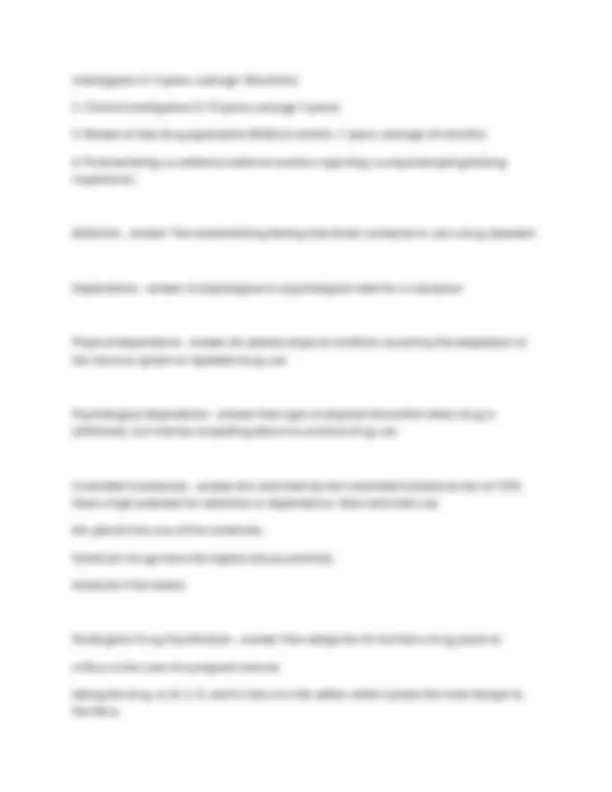
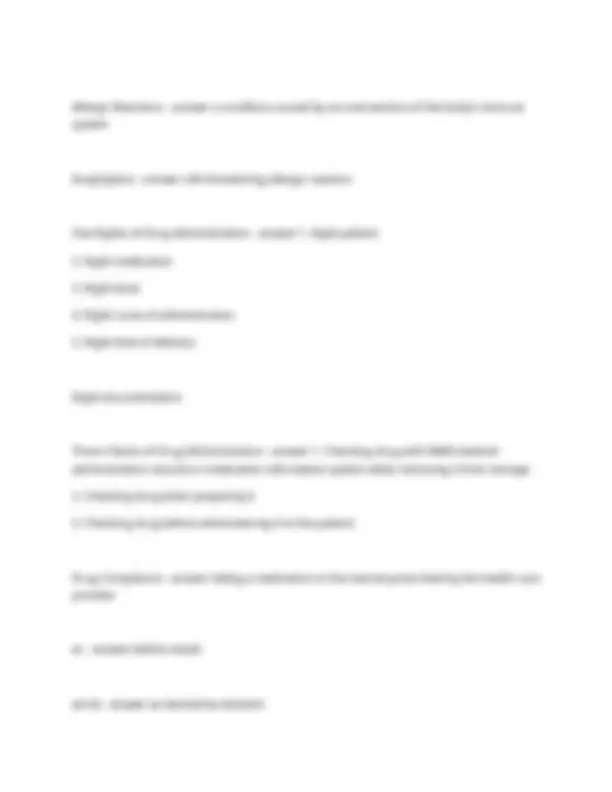
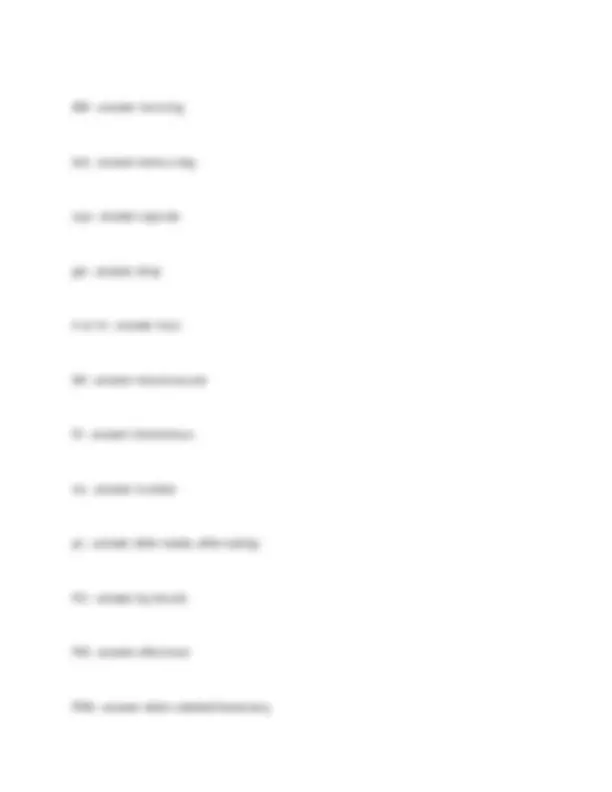

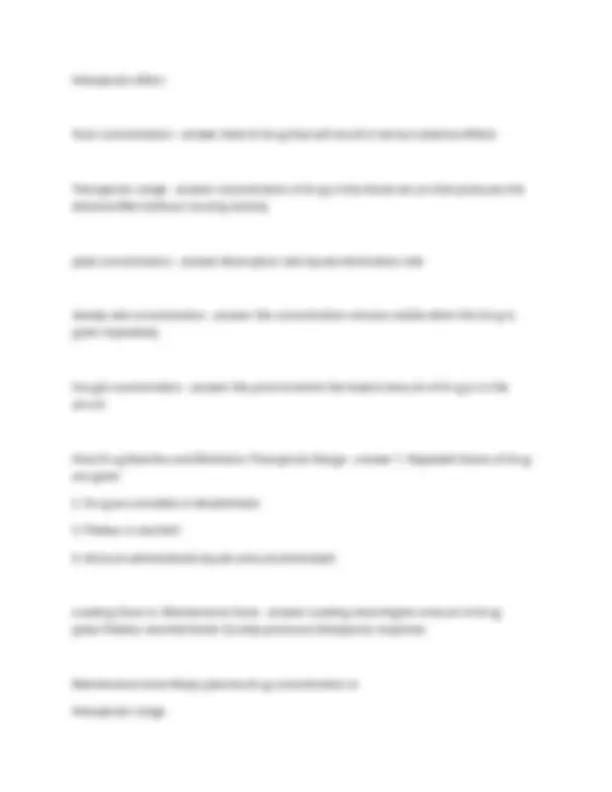
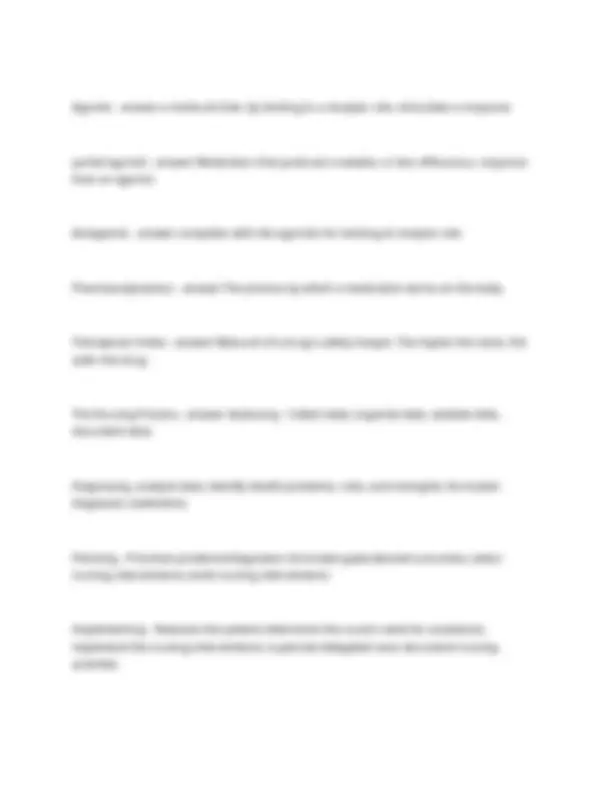
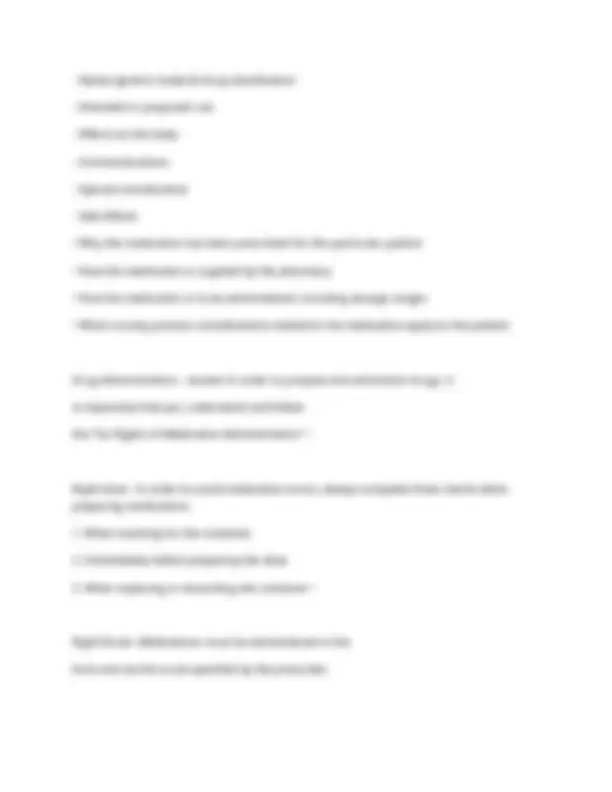
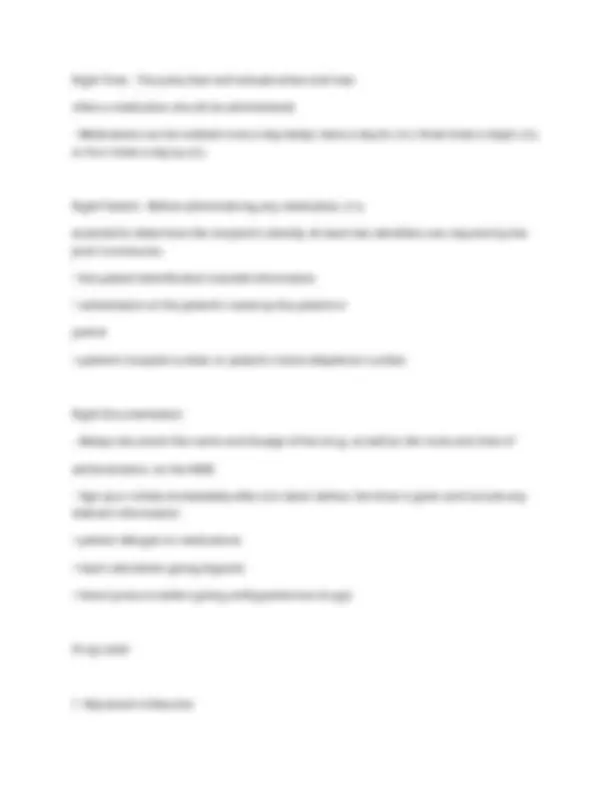
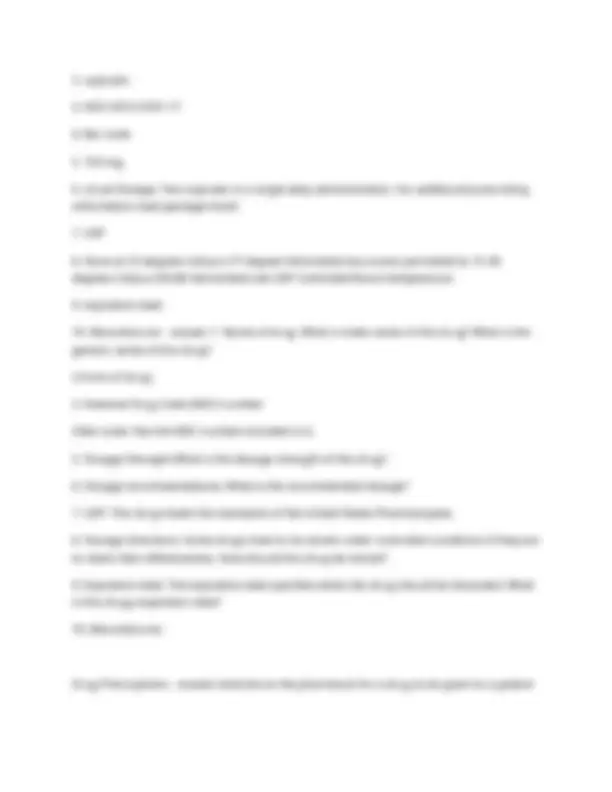
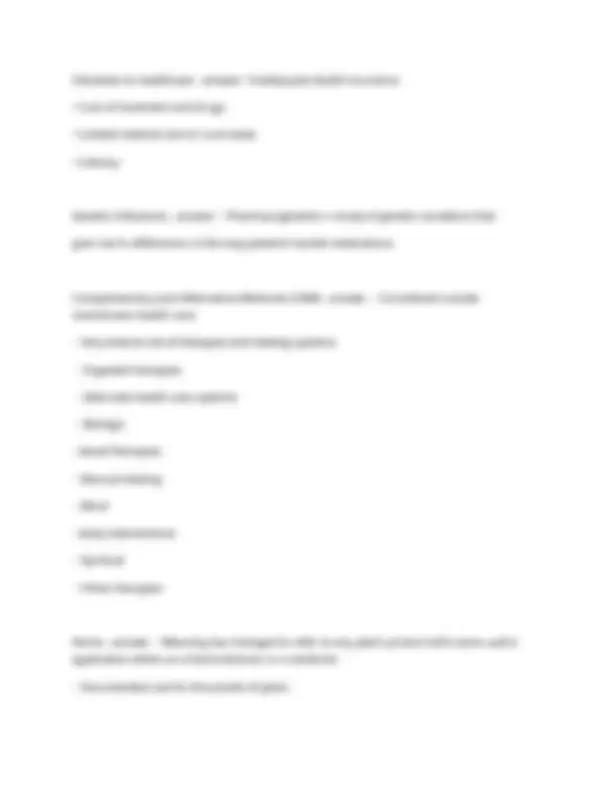
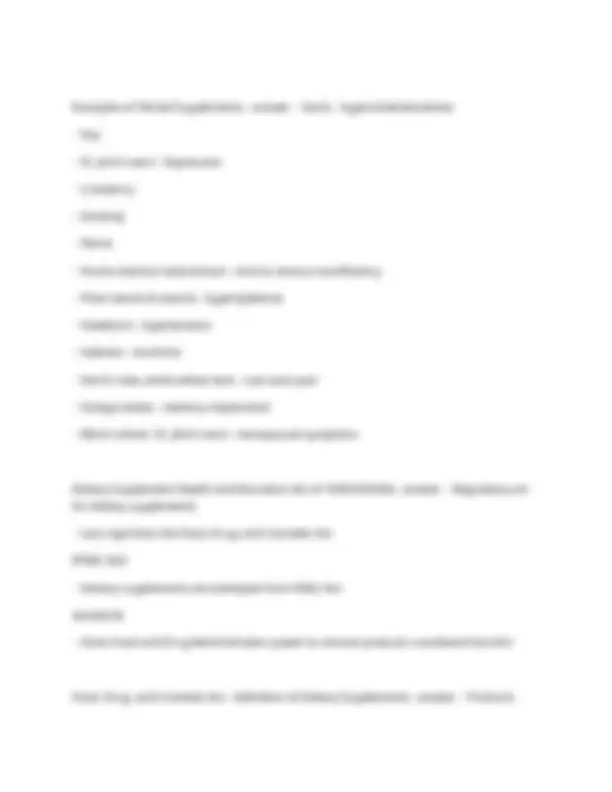
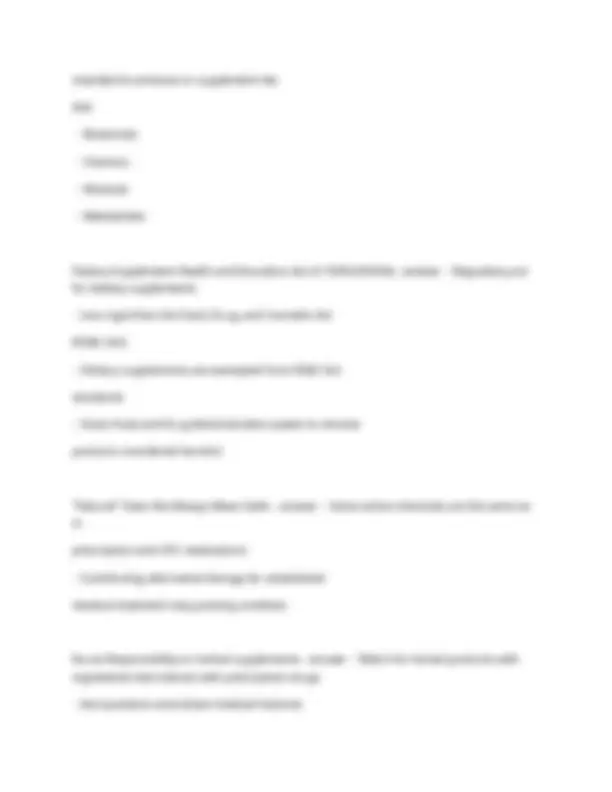
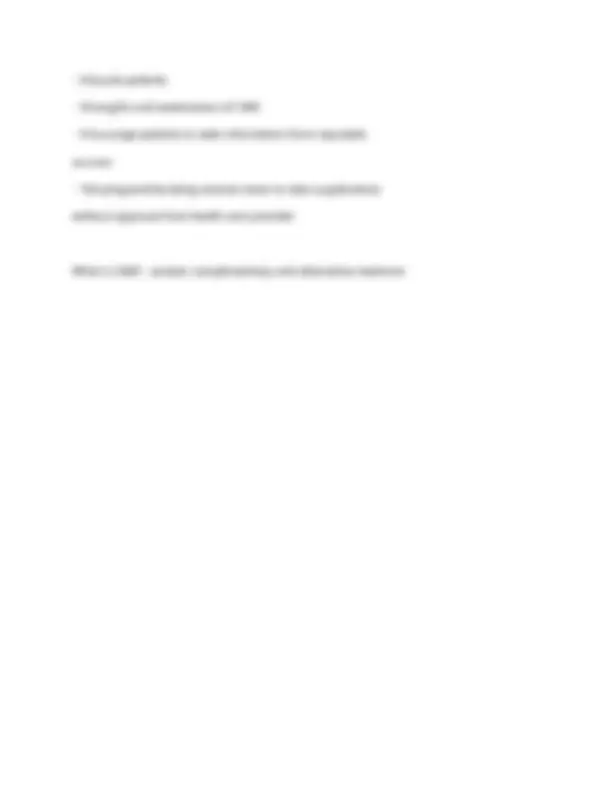


Study with the several resources on Docsity

Earn points by helping other students or get them with a premium plan


Prepare for your exams
Study with the several resources on Docsity

Earn points to download
Earn points by helping other students or get them with a premium plan
Community
Ask the community for help and clear up your study doubts
Discover the best universities in your country according to Docsity users
Free resources
Download our free guides on studying techniques, anxiety management strategies, and thesis advice from Docsity tutors
Pharmacology for Nurses. A Pathophysiologic Approach Adams - Holland - Urban (Unit 1) Exam With Complete Solutions.
Typology: Exams
1 / 21

This page cannot be seen from the preview
Don't miss anything!














Pharmacology - answer Study of medicine; how drugs are administered; where drugs travel in the body, Response that drugs produce. drug - answer A chemical substance that is taken to cause changes in a person's body or behavior medication - answer A substance that is used to treat or prevent disease or relieve pain. biologics - answer agents naturally produced in animal cells, in microorganisms, or by the body itself Mechanism of Action - answer how a drug produces its physiological effect in the body Bioavailability - answer the extent to which the body can absorb and use a nutrient Therapeutic classification of drugs: - answer Based on what the drug does clinically Pharmacologic Classification - answer Based on the drug's mechanism of action, or how the drug produces its effect Most Drugs have three names - answer Chemical, Generic, Trade (CHEMICAL: (1/2)-2-(p- isobutylphenyl) propionic acid; GENERIC: ibuprofen; TRADE: Motrin) Generic vs. Trade-Name Drugs - answer Trade name drugs with exclusive rights cost more. When rights end, competing companies offer generic form cheaper prescription drugs - answer Drugs legally available only with a physician's order. Over the counter drugs (OTC) - answer can be purchased without a prescription Black Box Warnings - answer One of the primary alerts for identifying extreme adverse drug reactions discovered
during and after the review process; 1997 FDA created "Black Box Warnings" Contraindications - answer factors that prevent the use of a drug or treatment why should healthcare professionals be concerned about patients taking herbal medicines? - answer patients could be putting themselves at risk, potential herb-drug interactions U.S. Pharmacopoeia (USP) - answer 1820; 1st comprehensive publication formulary used in the U.S.; drug purity, strength, and directions for synthesis. USP and National Formulary (NF) - answer 1852-1975, two drug standards in the US by the American Pharmaceutical Association (APhA). 1. USP - all drug products. 2. National Formulary (NF) - pharmaceutical ingredients. U.S. Pharacopoeia -National Formulary (USP-NF) - answer 1975 merged into a single publication Biologic Control Act - answer 1902 standardized serum and blood-related products Pure Food and Drug Act - answer 1906 - Established government control (FDA) for labeling medicines Shirley Amendment - answer 1912 - Prohibited drugs labeled with false therapeutic claims Food, Drug, and Cosmetic Act (1938) and amendments - answer 1938- Thorough testing of drug; Proof of safety and efficacy of drug Dietary Supplement Health and Education Act, 1994 - answer 1994-Controls misleading industry claims Four Stages of Approval for Therapeutic and Biologic Drugs - answer 1. Preclinical
Allergic Reactions - answer a condition caused by an overreaction of the body's immune system Anaphylaxis - answer Life threatening allergic reaction Five Rights of Drug Administration - answer 1. Right patient
AM - answer morning bid - answer twice a day cap - answer capsule gtt - answer drop h or hr - answer hour IM - answer intramuscular IV - answer intravenous no - answer number pc - answer after meals, after eating PO - answer by mouth PM - answer afternoon PRN - answer when needed/necessary
kidneys.
Agonist - answer a molecule that, by binding to a receptor site, stimulates a response partial agonist - answer Medication that produces a weaker, or less efficacious, response than an agonist. Antagonist - answer competes with the agonists for binding at receptor site Pharmacodynamics - answer The process by which a medication works on the body. Therapeutic Index - answer Measure of a drug's safety margin. The higher the value, the safer the drug. The Nursing Process - answer Assessing - Collect data; organize data, validate date, document data Diagnosing -analyze data; identify health problems, risks, and strengths; formulate diagnostic statements Planning - Prioritize problems/diagnoses; formulate goals/desired outcomes; select nursing interventions; write nursing interventions Implementing - Reassess the patient; determine the nurse's need for assistance; implement the nursing interventions; supervise delegated care; document nursing activities.
Evaluating - Collect data related to outcome; compare date with outcome; relate nursing actions to patients goals/outcomes; draw conclusions about problem status; continue, modify, or terminate the patient's care plan Assessment of the Patient - answer 1. Systematic collection, organization, validation, and documentation of patient data
Right Time - The prescriber will indicate when and how often a medication should be administered.
Medication orders (drug orders, physician's orders) - answer are directives to the pharmacist for the drugs used in a hospital or other healthcare facility. Orders are written in the sequence: drug name, dose, route, frequency -Written -Verbal -Routine -Standing -PRN -STAT Medication Orders - answer Date and time are necessary when an order is written.
Reporting and Documenting Medication Errors - answer • Utilize and incident report
Examples of Herbal Supplements - answer ◦ Garlic - hypercholesterolemia ◦ Soy ◦ St. John's wort - Depression ◦ Cranberry ◦ Ginseng ◦ Stevia ◦ Horse chestnut seed extract - chronic venous insufficiency ◦ Plant sterols & stanols - hyperlipidemia ◦ Hawthorn - hypertension ◦ Valerian - insomnia ◦ Devil's claw, white willow bark - Low back pain ◦ Ginkgo biloba - memory impairment ◦ Black cohosh, St. John's wort - menopausal symptoms Dietary Supplement Health and Education Act of 1994 (DSHEA) - answer ◦ Regulatory act for dietary supplements ◦ Less rigid than the Food, Drug, and Cosmetic Act (FD&C Act) ◦ Dietary supplements are exempted from FD&C Act standards ◦ Gives Food and Drug Administration power to remove products considered harmful Food, Drug, and Cosmetic Act - Definition of Dietary Supplements - answer ◦ Products
intended to enhance or supplement the diet ◦ Botanicals ◦ Vitamins ◦ Minerals ◦ Metabolites Dietary Supplement Health and Education Act of 1994 (DSHEA) - answer ◦ Regulatory act for dietary supplements ◦ Less rigid than the Food, Drug, and Cosmetic Act (FD&C Act) ◦ Dietary supplements are exempted from FD&C Act standards ◦ Gives Food and Drug Administration power to remove products considered harmful "Natural" Does Not Always Mean Safer - answer ◦ Some active chemicals are the same as in prescription and OTC medications ◦ Substituting alternative therapy for established medical treatment may prolong condition Nurse Responsibility on herbal supplements - answer ◦ Watch for herbal products with ingredients that interact with prescription drugs ◦ Ask questions and obtain medical histories